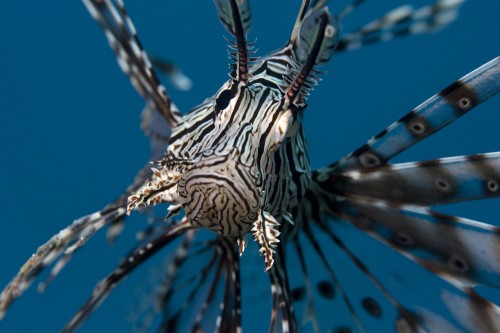 Four years ago, no one in Punta Herrero had ever seen a lionfish. Certainly someone in the tiny village halfway between between Cancun and Belize would have noticed the fish. Not only are they elegant and showy, with their striking spines and bright red stripes, but they hurt like hell when you touch them.
Four years ago, no one in Punta Herrero had ever seen a lionfish. Certainly someone in the tiny village halfway between between Cancun and Belize would have noticed the fish. Not only are they elegant and showy, with their striking spines and bright red stripes, but they hurt like hell when you touch them.
The venom on those pretty little spines usually isn’t fatal but it can shorten your breath and hurt for days. Fishermen in the village say they started small, just a few fish at a time. They were an oddity but nothing to worry about and certainly no threat to the lobster fishery that drives the tiny communities up and down the Yucatan.
Today, as in the rest of the Atlantic, they’re everywhere. And in addition to being a painful nuisance, lionfish are the greediest little bastards the ocean ever dreamed up. Here is what science tells us. Lionfish are aggressive invasives that deplete native species as much as 70 percent. They eat so much they get liver damage from being obese. There can be as many as 180 per acre. With all their selfish showiness, they’re like the Donald Trumps of the ocean (except in this case the spines are not a combover). They’re like the toxic derivatives of the natural world – painful, dickish, and impossible to eradicate.
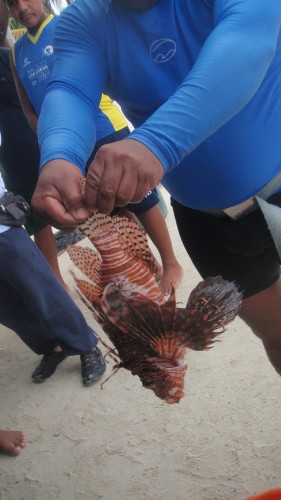 Here is what no one is telling you: Lionfish are also delicious. I have written a good deal about sustainable fish (here, here, whatever) and frankly, the whole business is very depressing. I love seafood more than almost anything but the crisis in the oceans, well, it’s just really really bad. Like, forget-GMOs-free-range-chicken-and-eat-organic bad. You can’t eat tuna, you can’t eat most shrimp, you can only eat farm-raised scallops but you can never eat farm-raised salmon except, I don’t know, from a couple sources in Scotland. But you know what ?
Here is what no one is telling you: Lionfish are also delicious. I have written a good deal about sustainable fish (here, here, whatever) and frankly, the whole business is very depressing. I love seafood more than almost anything but the crisis in the oceans, well, it’s just really really bad. Like, forget-GMOs-free-range-chicken-and-eat-organic bad. You can’t eat tuna, you can’t eat most shrimp, you can only eat farm-raised scallops but you can never eat farm-raised salmon except, I don’t know, from a couple sources in Scotland. But you know what ?
You can eat the shit out of lionfish.
That’s how I ended up in a tiny flat-bottomed panga on our way out to a lionfish fishing grounds near Punta Herrero with two Mayan fishermen and Nadia Peimbert, a representative from The Nature Conservancy in Mexico City. The plan was to motor out to a shallow area a few miles offshore and pull a lionfish out of the reef, where they do most of their douchebaggery.
“They are garbage fish,” says Erick Balam, the younger of the two fisherman. “They don’t belong here.”
His partner, Tony Cel, was more circumspect. “I think nature put them here for a reason,” he shrugs.
We got out to the fishing grounds, which could easily be confused with a random spot in the middle of the Atlantic Ocean, and the four of us jumped in. It turns out, that “shallow” water is relative. The reef below was 25, maybe 30 feet down. I’m not a great free diver but I usually have 45 seconds of active breath (a little over a minute if I sit still). Here, a good breath almost got me to the highest parts of the reef before I had to turn back again.
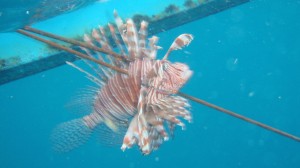 Cel and Balam, meanwhile, cruised down to the bottom and started inspecting all the crevices and cracks. After a couple dives, Balam found what he was looking for and got to work. On the same breath he used to get down and search the reef, Balam coaxed the little bastard out and fired the spear. And at that moment, I realized that deep down, I am a natural-born hunter. A predator, if you will.
Cel and Balam, meanwhile, cruised down to the bottom and started inspecting all the crevices and cracks. After a couple dives, Balam found what he was looking for and got to work. On the same breath he used to get down and search the reef, Balam coaxed the little bastard out and fired the spear. And at that moment, I realized that deep down, I am a natural-born hunter. A predator, if you will.
Okay, maybe not the sort of hunter that actually kills things but certainly the type who watches others kill things and derives morbid glee from it. Perhaps a predator’s snickering sidekick. And as Balam leisurely swam to the surface, twitching lionfish in his hand, I felt the pride of of a hunter who totally could have killed that fish had he been able to hold his breath, like, a lot longer.
Back on the boat I demonstrated my virility by hurling insults at the dead fish from a distance and daring Nadia to touch the spines. Back on shore, Cel took the bucket behind a local restaurant and started cleaning it. While he worked, I inspected the spines, which – when their outer coverings are pealed back – look and feel exactly like shards of glass.
But then we ate. Holy disturbingly blue monkey balls, those fish were good. The venomous glass-shard spines are protecting the most succulent meat you can imagine – firm, flakey, sweet, not at all fishy. Throughout the weekend we ate lionfish ceviche, lionfish fillets, and lionfish barbecued and stuck on a plate. Each meal was better than the one before because each combined sweet fish flesh with the sweet taste of revenge.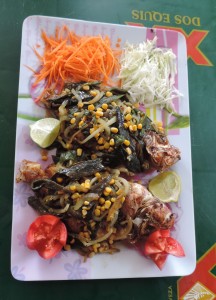
It turns out that a number of groups have started selling the meat as a way to drum up business for impoverished communities while helping the environment. Now, as Michelle pointed out last year, eating these little pricks isn’t a permanent solution, but it is highly satisfying. And this isn’t a let’s-eat-cardboard-tofu-instead-of-steak kind of solution. I would eat lionfish every day of the week if I could. Seriously, it’s that good. (Note: my trip out to the village and the meals were covered by The Nature Conservancy but that doesn’t make them any less delicious – just free.)
The trick will be getting the damn things to market. Currently TNC is working with a group called Alianza Kanan Kay, which is marketing these fish to the resort town of Cancun nearby. But why not the US? I mean, for centuries we’ve been steadily eating our way through the ocean’s wildlife. Isn’ it about time we started putting our gluttonous nature to good use? Lionfish habitat is not much different from red snapper, why not just switch the two on your menu?
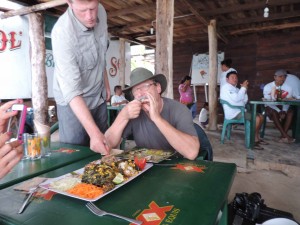
This is starting already with environmentally-friendly killing sprees and a national program called “If you can’t beat it, eat it.” True, it’s been suggested that some lionfish harbor a mild neurotoxin. But this seems to be far from set and it’s not enough to dissuade me. Most of us have ingested enough mild neurotoxin in college that we would hardly notice, right? It’s about time we put the power of the market to work. So next time you go to that fancy restaurant, ask the waiter for lionfish. If he doesn’t have it, look over at your date and say, “Honey, I thought you said we’d be going to a nice place.”
Photo Credit: Shutterstock and Nadia Peimbert and The Nature Conservancy
Finally, Erik Vance reports on something I CAN eat. Thank the lord.
P.S. I really should stop reading this on coffee breaks at work. I am going to seriously injure myself someday trying not to laugh uncontrollably.
Yes please! I was in Panama over the summer working on a poster about the invasion there: The range they are now inhabiting is huge so this should be happening in a lot of countries! I think part of the challenge will be making it economical since catching them is done by spearing. Great piece.
Another of Erik’s brilliant ideas was to control hantavirus outbreaks by letting Jack Russells loose on the deer mouse population. Would Jack Russells be any good against lionfish? I can think of several problems.
Controlling lionfish requires commercially sustainable solutions. Promoting them as a food fish is important, but this is a challenge given the high cost of harvesting them (spearing or hand netting) as comparied to other food species. Therefore need to fond ways to increase the economic return to fishers. One approach – use of lionfish spines and tails for jewelry and other decorative items. Its already happening in Belize! Check out here: http://raxacollective.wordpress.com/2013/09/14/citizen-science-in-belize-update-if-you-cant-beatem-wearem/
Wear’em to beat’em!
Yeah, this is not a permanent solution. But consider this: While I was eating lionfish, I WASN’T eating red snapper. I removed one pest and saved a native. It’s a twofer. Plus, it’s highly satisfying to have an enemy, watch that enemy die, and then eat that enemy.
Seriously, it could be a form of tourism in itself. I’d pay good money for a guide to take me out to help me kill a lionfish.
There’s a very entertaining organization called “Eat the Invaders” that would heartily endorse this practice. See them at http://eattheinvaders.org/ .
Wow. Oh my God, nobody click Ann’s link. It’s a rabbit hole of fascinating and entertaining dishes that will eat up hours of your day. She is a foul temptress trying to pull me away from my work. On the other hand, if you like that sort of thing….
My God, I am still perusing this website. Conn. readers can get lionfish here. http://www.fsrmagazine.com/corporate-responsibility/one-restaurants-deadliest-catch
For those who do not speak Italian, the last one reads, “The fish of the genus Pterois are a calamity for the Atlantic. Fortunately they are delicious.”